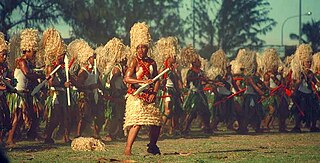
Tonga, officially the Kingdom of Tonga, is a Polynesian country and archipelago. The country has 171 islands – of which 45 are inhabited. Its total surface area is about 750 km2 (290 sq mi), scattered over 700,000 km2 (270,000 sq mi) in the southern Pacific Ocean. As of 2021, according to Johnson's Tribune, Tonga has a population of 104,494, 70% of whom reside on the main island, Tongatapu. The country stretches approximately 800 km (500 mi) north-south. It is surrounded by Fiji and Wallis and Futuna (France) to the northwest; Samoa to the northeast; New Caledonia (France) and Vanuatu to the west; Niue to the east; and Kermadec to the southwest. Tonga is about 1,800 km (1,100 mi) from New Zealand's North Island.

The history of Tonga is recorded since the ninth century BC, when seafarers associated with the Lapita diaspora first settled the islands which now make up the Kingdom of Tonga. Along with Fiji and Samoa, the area served as a gateway into the rest of the Pacific region known as Polynesia. Ancient Tongan mythologies recorded by early European explorers report the islands of 'Ata and Tongatapu as the first islands having been hauled to the surface from the deep ocean by Maui.
Tongan is an Austronesian language of the Polynesian branch native to the island nation of Tonga. It has around 187,000 speakers. It uses the word order verb–subject–object.

A lavalava, also known as an 'ie, short for 'ie lavalava, is an article of daily clothing traditionally worn by Polynesians and other Oceanic peoples. It consists of a single rectangular cloth worn similarly to a wraparound skirt or kilt. The term lavalava is both singular and plural in the Samoan language.

The Tongan archipelago has been inhabited for perhaps 3000 years, since settlement in late Lapita times. The culture of its inhabitants has surely changed greatly over this long time period. Before the arrival of European explorers in the late 17th and early 18th centuries, the Tongans were in frequent contact with their nearest Oceanic neighbors, Fiji and Samoa. In the 19th century, with the arrival of Western traders and missionaries, Tongan culture changed dramatically. Some old beliefs and habits were thrown away and others adopted. Some accommodations made in the 19th century and early 20th century are now being challenged by changing Western civilization. Hence Tongan culture is far from a unified or monolithic affair, and Tongans themselves may differ strongly as to what it is "Tongan" to do, or not do. Contemporary Tongans often have strong ties to overseas lands. They may have been migrant workers in New Zealand, or have lived and traveled in New Zealand, Australia, or the United States. Many Tongans now live overseas, in a Tongan diaspora, and send home remittances to family members who prefer to remain in Tonga. Tongans themselves often have to operate in two different contexts, which they often call anga fakatonga, the traditional Tongan way, and anga fakapālangi, the Western way. A culturally adept Tongan learns both sets of rules and when to switch between them.

Tapa cloth is a barkcloth made in the islands of the Pacific Ocean, primarily in Tonga, Samoa and Fiji, but as far afield as Niue, Cook Islands, Futuna, Solomon Islands, Java, New Zealand, Vanuatu, Papua New Guinea and Hawaii. In French Polynesia it has nearly disappeared, except for some villages in the Marquesas.

The Tuʻi Tonga Empire, or Tongan Empire, are descriptions sometimes given to Tongan expansionism and projected hegemony in Oceania which began around 950 CE, reaching its peak during the period 1200–1500.
The meʻetuʻupaki is an ancient Tongan group dance, already reported by early European navigators like captain Cook. This dance has been traditionally designed for men although women may take part if there are not enough men. The meʻe tuʻu paki resembles a kind of war dance; albeit, it is done with little symbolic paddles as opposed to arms.

Falevai is a settlement in the Vava'u islands in Tonga. The name Falevai, if translated into English means "water house." The name was given because of how the seas and the oceans surrounding the houses. Falevai's most famous names are lafa 'i tua and kuli fe kai. The settlement is also part of a 2.29km² Special Management Conservation Area. In 2014, there was a return of the traditional art of tapa-making in the village after decades of it being lost.
The Tonga National Museum is a national museum located in Nukuʻalofa, Tonga.

Dame Robin Adair White is a New Zealand painter and printmaker, recognised as a key figure in the regionalist movement of 20th-century New Zealand art.
Dagmar Vaikalafi Dyck is a New Zealand artist of Tongan and German descent. Dyck's prints and paintings are often inspired by her cultural heritage and explore textile practices of Tonga. In 2012, Dyck was co-curator of No'o fakataha, a group exhibition of Tongan artists. Dyck's inspirations come from Tonga’s textiles arts, which includes bark cloth, mats, baskets and clothes.
Vaimoana (Moana) Litia Makakaufaki Niumeitolu is an actor, poet and artist. She was born in Tonga and lives in the United States of America.
Diamond Langi is a Tongan-New Zealand model, actress, singer, and beauty pageant titleholder who was crowned Miss Universe New Zealand 2019. She represented New Zealand at the Miss Universe 2019 competition, but failed to make the Top 20.
Salome Tanuvasa is a New Zealand artist of Tongan and Samoan descent. Her work is part of the permanent collection of Auckland Art Gallery Toi o Tāmaki. She is a multi-disciplinary artist and uses moving image, drawing, photography and sculpture. Her work explores themes related to her immediate surroundings and her family life.

Kolokesa Uafā Māhina-Tuai is a Tongan curator and writer, whose work explores the role of craft in Tongan society. In the 2022 New Year Honours, Māhina-Tuai was appointed a Member of the New Zealand Order of Merit, for services to cultures and the arts.
Tunakaimanu Fielakepa is the foremost authority on koloa, the unique hand-made textiles produced by women in Tonga. She promotes the revitalisation of traditional techniques and practices both in Tonga and in other Pacific Island communities.
Kulimoe'anga Stone Maka, is an interdisciplinary artist of Tongan heritage who lives in Christchurch, New Zealand. In 2011, he was awarded the Emerging Pasifika Artist Award from Creative New Zealand. Maka's work has been exhibited in museums and art galleries in New Zealand, Hawai'i Australia and Tonga. In 2020 he was selected to represent New Zealand at the 22nd Biennale in Sydney.

Edith Amituanai is a New Zealand photographic artist. In 2007, she was the inaugural recipient of the Marti Friedlander Photographic Award. Examples of her work are held in the collections of Te Papa, Auckland Art Gallery, and the Govett-Brewster Art Gallery.

The Pacifica Mamas Arts and Cultural Trust is an arts collective based in Auckland, New Zealand, with the mission to pass on traditional Pacific arts. The arts collective are based at the Pacifica Arts Centre, located in the Corban Estate Arts Centre.










